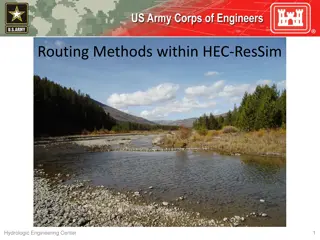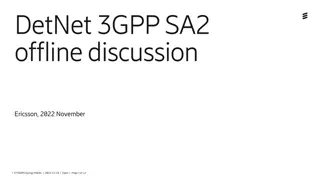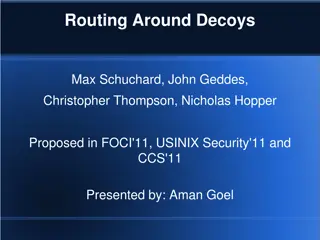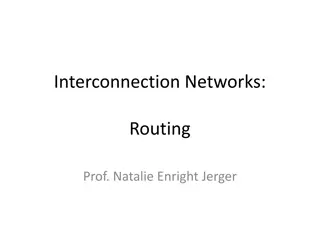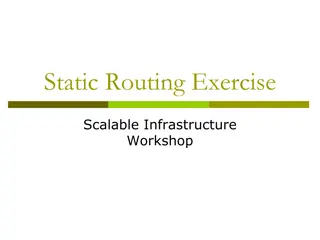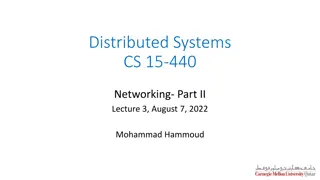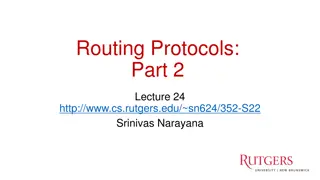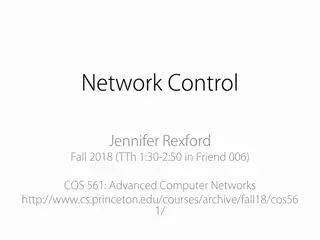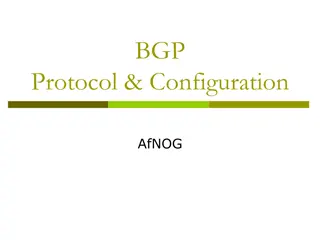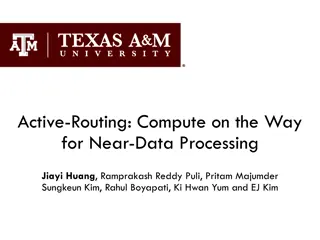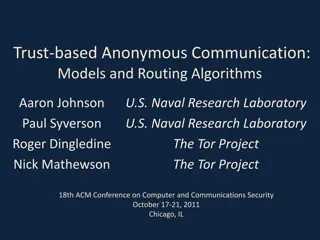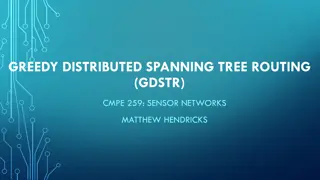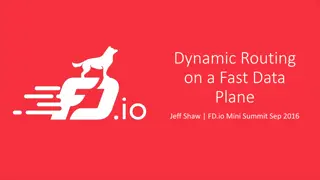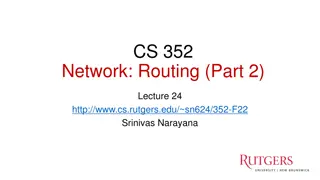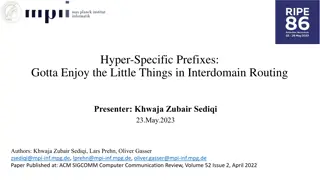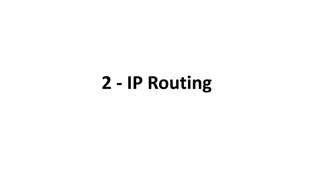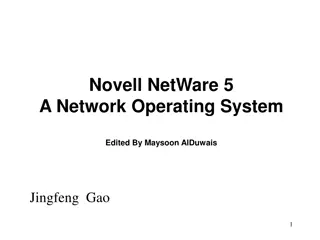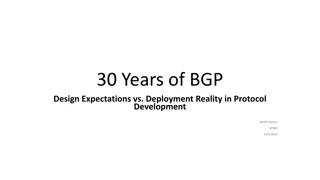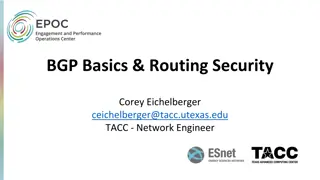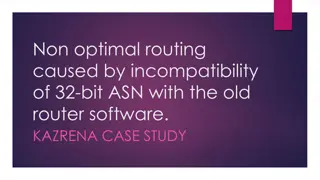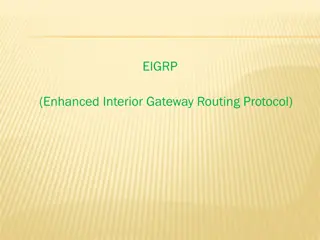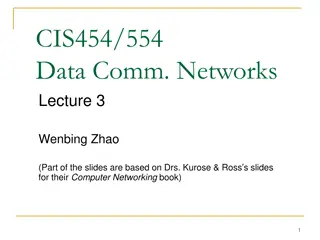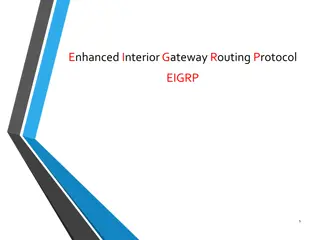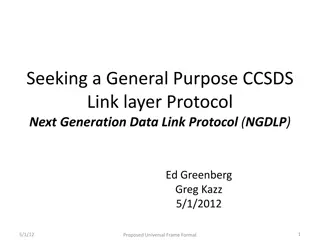Adaptive Tree-based Convergecast Protocol
Adaptive tree-based protocol for managing overlay networks in heterogeneous networks. It proposes improvements to the existing Tree-Based Convergecast Routing (TBCR) protocol by considering additional parameters such as RTT, power consumption, link stability, and link mobility to optimize routing de
32 views • 12 slides
Master GB0-372 Ace H3C Advanced Routing & Switching Technology 1 Exam
Elevate your career with success in the GB0-372 exam. Master H3C Advanced Routing and Switching Technology 1 with our comprehensive study materials, practice tests, and expert guidance. Prepare effectively for the H3C GB0-372 exam and gain the skills and knowledge necessary to excel in advanced rout
2 views • 8 slides
Understanding Routing Methods in Hydrologic Engineering Center (HEC-ResSim)
Explore the differences between hydrologic and hydraulic routing, learn about open channel flow processes, and delve into channel routing within HEC-ResSim. Discover various reach routing methods, parameter estimation techniques, and calibration approaches. Dive into the Muskingum method and its app
6 views • 29 slides
Understanding Mobile Computing and TCP/IP Protocol Suite
Mobile computing is crucial for continuous internet connectivity regardless of physical location. The TCP/IP protocol suite, consisting of Transmission Control Protocol (TCP) and Internet Protocol (IP), forms the backbone of internet infrastructure. IP addressing and mobility challenges are addresse
1 views • 51 slides
DetNet 3GPP SA2 Offline Discussion Summary
The DetNet 3GPP SA2 offline discussion held by Ericsson in November 2022 covers several outstanding issues related to DetNet architecture, including support for an optional NEF, uplink routing information reporting, and the role of NEF in protocol conversion. Three alternative approaches for NEF imp
0 views • 12 slides
Understanding OSI Model and TCP/IP Protocol Suite in Computer Networking
This chapter explores the OSI model and TCP/IP protocol suite, delving into protocol layers, addressing mechanisms, and network components. It highlights the interface between layers, functions of each layer in the OSI model, and compares TCP/IP protocol suite layers with OSI model layers. The discu
0 views • 30 slides
Understanding EIGRP: A Comprehensive Overview
Enhanced Interior Gateway Routing Protocol (EIGRP) is a dynamic routing protocol providing various advantages to network administrators. It is a classless routing protocol supporting VLSM and is considered an Interior Gateway Protocol (IGP). EIGRP uses advanced distance vector routing and is known f
1 views • 5 slides
Decoy Routing: A Tool Against Internet Censorship
Modern censorship resistance tools like decoy routing provide a new approach against web censorship at a nation-state level. Decoy routing involves placing a proxy in the middle of paths to hide user packets from detection by adversaries. The use of decoys helps in avoiding the enumeration of censor
0 views • 20 slides
Direct Routing with Teams: Opportunity or Threat?
Microsoft's shift in cloud architecture for voice services opens up new possibilities for enterprises and carriers with Teams Direct Routing. This allows seamless integration of PSTN services directly to the cloud, offering flexibility in maintaining existing contracts while transitioning to Teams a
0 views • 10 slides
Understanding Routing in Interconnection Networks
Routing in interconnection networks involves distributing traffic evenly among paths to avoid hotspots and contention, aiming for balanced throughput. Various routing algorithms, such as greedy, uniform random, and adaptive, are discussed with examples highlighting their impact on network performanc
2 views • 38 slides
Geometric Routing Concepts and Byzantine Fault Tolerance
Geometric Routing enables routing without overhead, where each node knows its global coordinates and forwards messages based on proximity to the destination. Byzantine Faults pose challenges with arbitrary node behavior, but a Byzantine-Robust Geometric Routing algorithm addresses this in a 3-connec
2 views • 33 slides
Configuration Examples for IP SLA with Object Tracking
Learn how to configure and troubleshoot IP SLA with Object Tracking using detailed examples for Static Routing, HSRP, and Policy Based Routing. Find out where Object Tracking can be implemented and when not to use it in various network scenarios. Understand the configuration components, including de
2 views • 17 slides
Understanding Static Routing in Network Infrastructure Workshops
Explore the concepts of static routing in networking workshops, covering Unix and Cisco network interface configurations, static routes, default routes, and advantages and disadvantages of static routing. Learn about IP routing configuration, assignment of IPv4 addresses, and FreeBSD network interfa
4 views • 37 slides
Understanding Router Routing Tables in Computer Networks
Router routing tables are crucial for directing packets to their destination networks. These tables contain information on directly connected and remote networks, as well as default routes. Routers use this information to determine the best path for packet forwarding based on network/next hop associ
0 views • 48 slides
Understanding Networking Principles and Routing Algorithms in Distributed Systems
Delve into the intricacies of networking principles and routing algorithms in distributed systems. Explore the four layers studied, including the network layer that handles routing. Discover the role of routers in forwarding packets between networks and the challenges of designing routing algorithms
1 views • 23 slides
Understanding Internet Routing Protocols
Explore the intricacies of routing protocols in the context of the Internet's large federated network. Delve into the concepts of reachability, message exchange, algorithm design, and the challenges posed by running an autonomous system. Gain insights into the Border Gateway Protocol (BGP) and inter
1 views • 26 slides
Network Routing Algorithms and Protocols Overview
Understanding network routing algorithms and protocols is crucial in the field of networking. This content provides insights into the initialization process, loop prevention mechanisms, and the use of algorithms like OSPF and IS-IS. It also touches on routing protocols such as RIP and EIGRP, explain
0 views • 17 slides
Understanding BGP Protocol and Configuration for Routing Policy Filtering
Explore the terminology, reasons, and methods behind routing policy filtering in the context of BGP protocol configuration. Learn how to control traffic routing preferences, filter routes based on AS or prefix, and use regular expressions for complex filtering rules. Discover the importance of AS-Pa
0 views • 29 slides
Active Routing for Near-Data Processing in Memory Networks
Explore the concept of active routing and its role in optimizing data movement and computation in memory networks. Motivated by the need for efficient processing of large datasets, this research delves into architecture, implementation, and enhancements of active routing. By leveraging near-data pro
0 views • 50 slides
Trust-Based Anonymous Communication Models and Routing Algorithms
This research paper discusses trust-based anonymous communication models and routing algorithms in the context of onion routing, emphasizing the importance of trust in mitigating security risks from adversaries with resources. The paper presents a model of trust and proposes trust-based routing algo
0 views • 65 slides
Energy Harvesting Opportunistic Routing in Wireless Sensor Networks
Extending the lifetime of wireless sensor networks by harnessing ambient energy sources through opportunistic routing protocols. EHOR enhances efficiency and goodput compared to traditional routing methods, particularly in WSNHEAP environments. The protocol optimizes energy usage and data delivery b
0 views • 23 slides
Understanding Greedy Distributed Spanning Tree Routing in Wireless Sensor Networks
Wireless sensor networks play a critical role in various applications, and the Greedy Distributed Spanning Tree Routing (GDSTR) protocol, developed by Matthew Hendricks, offers an efficient routing approach. This protocol addresses challenges such as scalability, dynamic topologies, and sensor node
0 views • 34 slides
Understanding Dynamic Routing on Fast Data Plane with VPP and BIRD
Explore the concept of dynamic routing on a fast data plane featuring VPP (Vector Packet Processing) and BIRD (Internet Routing Daemon). Learn how packets traverse a graph, routing mechanisms like BGP, RIP, OSPF, and how sockets and plugins interact to forward traffic efficiently. Discover how VPP a
0 views • 12 slides
Challenges in Establishing a Secure Inter-Domain Routing System
The daunting task of creating a secure and trusted inter-domain routing system poses significant challenges due to the decentralized nature of the internet. Addressing issues such as propagation of false routing information, ensuring correct reachability, and dealing with the lack of a clear truth m
0 views • 15 slides
Understanding Routing Protocols in Network Layer
Routing protocols in the network layer dictate how data packets are routed through a network. This lecture delves into key concepts such as reachability, routing protocol components, and the workings of Distance Vector (DV) algorithms. It explains how updates propagate in networks efficiently with D
0 views • 31 slides
Understanding Hyper-Specific Prefixes in Internet Routing
Delve into the world of Hyper-Specific Prefixes (HSPs) in Internet routing as authors analyze the prevalence, visibility, and consistency of these unique routing elements. Exploring BGP best practices, related work, and methodological approaches, the study uncovers the nuances of HSPs' presence and
0 views • 31 slides
Adaptive Resilient Routing via Preorders in SDN
This research paper discusses the challenges of path-based routing in modern networks and introduces a novel approach called Adaptive Resilient Routing via Preorders in Software-Defined Networking (SDN). The authors emphasize the limitations of traditional routing schemes, the importance of resilien
0 views • 42 slides
Understanding IP Routing and Switching in Computer Networks
In the world of computer networking, IP routing and switching play crucial roles in ensuring efficient data transmission. Switches make decisions based on MAC addresses, while routers route based on IP information. By managing routing tables and using static or dynamic routing protocols, networks ca
0 views • 13 slides
Understanding Novell NetWare: A Comprehensive Overview
Novell NetWare is a network operating system developed by Novell to connect, manage, and maintain networks and their services. It comprises a suite of software components that run on NetWare servers and workstations. The system includes protocols such as IPX, Novell Routing Information Protocol (RIP
0 views • 22 slides
Updates and Changes in SPA/SPAC Processes
Changes and updates to SPA/SPAC processes include new team members, carryforward form submission instructions, Kuali Research routing adjustments, and a new routing process for proposals. These updates aim to streamline procedures and improve efficiency in award management. Routing process changes w
0 views • 31 slides
Evolution of BGP: Expectations vs. Reality in Protocol Development
BGP has evolved over 30 years from its origins as an advancement of EGP in the 1980s to address issues like routing explosion, IPv6 integration, and imperfections such as session insecurity and protocol instability. Despite challenges, BGP remains a critical component of inter-domain routing, adapti
0 views • 10 slides
Understanding BGP Basics and Routing Security
Border Gateway Protocol (BGP) is a crucial protocol used by routers to exchange routing information and make routing decisions. This protocol plays a key role in how the Internet functions, with over 76,000 Autonomous Systems and millions of routes being advertised. Research and Education (R&E) netw
0 views • 33 slides
Understanding Non-Optimal Routing and 32-Bit ASN Compatibility
Explore the challenges caused by the incompatibility of 32-bit ASN with old router software, leading to non-optimal routing issues. Learn about Autonomous Systems, AS Numbers, BGP asymmetric routing, and the importance of routing software supporting 32-bit ASN. Discover how outdated software replace
0 views • 8 slides
Understanding EIGRP Network Protocol
EIGRP (Enhanced Interior Gateway Routing Protocol) is a network protocol that facilitates efficient information exchange among routers. Evolving from IGRP, EIGRP allows interoperability and can be used for IP, AppleTalk, and Novell NetWare networks. EIGRP metrics scale IGRP metrics by a factor of 25
0 views • 13 slides
Understanding Protocol Deviations in Clinical Trials
Protocol deviations are expected occurrences in clinical trials that may arise from site or participant actions. It is crucial for research teams to identify, report, and learn from these deviations to ensure the integrity and safety of the study. Mechanisms for identifying and reporting deviations,
0 views • 16 slides
Understanding IP Addressing and Routing in Computer Networks
IP (Internet Protocol) operates at Layer 3 of the OSI model and TCP/IP stack, facilitating the routing of data packets over computer networks. It is a connectionless protocol that uses hierarchical addressing to efficiently route packets to their destinations. IP addressing, such as the 32-bit IPv4
0 views • 39 slides
Understanding Protocol Layers in Computer Networking
Explore the concept of protocol layers in computer networks for organizing the structure of complex systems. Learn about the organization of network functionality similar to air travel processes and the benefits of layering in dealing with complex systems. Delve into the Internet Protocol Stack, hig
0 views • 29 slides
Understanding Enhanced Interior Gateway Routing Protocol (EIGRP)
Enhanced Interior Gateway Routing Protocol (EIGRP) is an advanced version of IGRP that categorizes routes into interior, system, and exterior routes. EIGRP offers fast convergence, supports VLSM, and uses the DUAL algorithm. It involves neighbor discovery, route exchange processes, configuration ste
0 views • 11 slides
Seeking a General-Purpose CCSDS Link Layer Protocol: Next-Generation Data Link Protocol (NGDLP)
This document discusses the proposed Universal Frame Format for a next-generation data link protocol, focusing on major questions about transfer frames, Protocol Link Transmission Unit (PLTU), and Universal Transfer Frame Structure. It explores topics such as frame formats, telemetry transfer frames
0 views • 24 slides
NT Awake Proning Protocol for Non-Intubated Patients
This protocol outlines the benefits and procedure for prone positioning in non-intubated patients experiencing mild to moderate hypoxemia. It highlights patient eligibility criteria, equipment required, and considerations for nursing care. The protocol emphasizes improving oxygenation by promoting a
0 views • 11 slides


